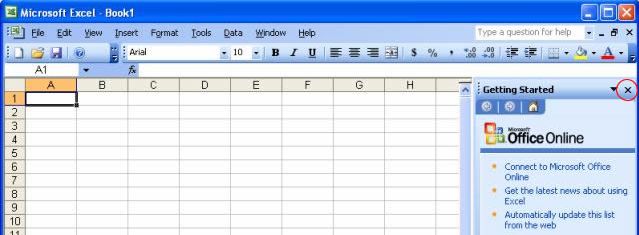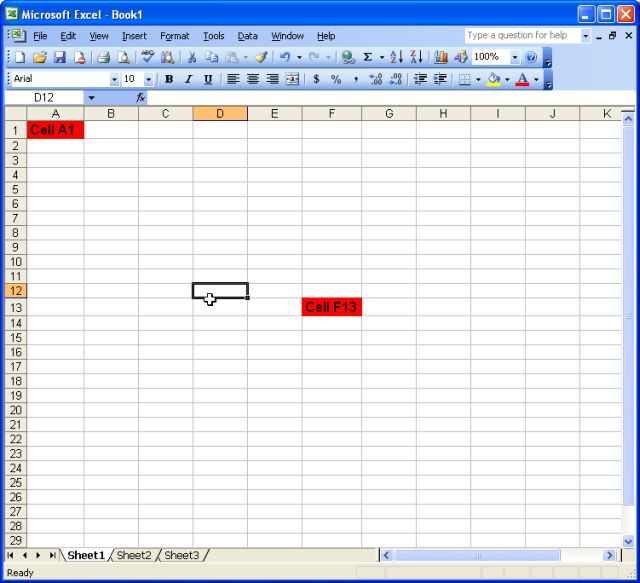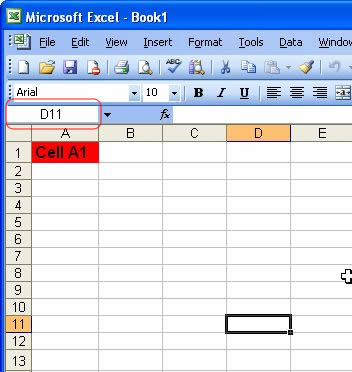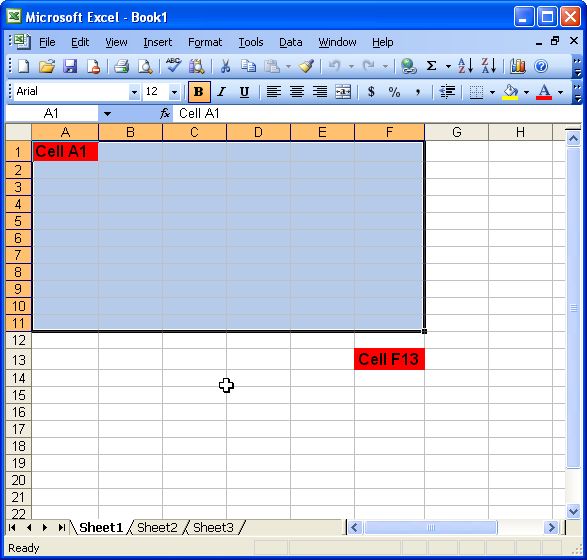The screen shown here will appear.
The Title Bar
This lesson will familiarize you with the Microsoft Excel screen. You will start with the Title bar, which is located at the very top of the screen. On the Title bar, Microsoft Excel displays the name of the workbook you are currently using. At the top of your screen, you should see "Microsoft Excel - Book1" or a similar name. The position of "Book 1" depends on the version of Excel you are using.
The Menu Bar
The Menu bar is directly below the Title bar. The menu begins with the word File and continues with Edit, View, Insert, Format, Tools, Data, Window, and Help. You use a menu to give instructions to the software. Point with your mouse to a menu option and click the left mouse button. A drop-down menu opens. You can now use the left and right arrow keys on your keyboard to move left and right across the Menu bar. You can use the up and down arrow keys to move up and down the drop-down menu. To choose an option, highlight the item on the drop-down menu and press Enter. An ellipse after a menu item signifies additional options; if you choose that option, a dialog box opens.
Do the following exercise, which demonstrates using the Microsoft Excel menu bar.
- Point to the word File, which is located on the Menu bar.
- Click your left mouse button.
- Press the right arrow key until Help is highlighted.
- Press the left arrow key until Format is highlighted.
- Press the down arrow key until Style is highlighted. Press the up arrow key until Cells is highlighted.
- Press Enter to choose the Cells menu option.
- Point to Cancel and click the left mouse button to close the dialog box.
When using Microsoft Excel, you can set an option to tell Microsoft Excel to always show full menus or to show only the most frequently and recently used options. All the lessons in this tutorial assume you have your menus set to Always Show Full Menus. To set your menu to display full menus:
- Point to the word Tools, which is located on the menu bar.
- Click your left mouse button.
- Press the down arrow until customize is highlighted.
- Press Enter.
- Choose the Options Tab by clicking on it.
- If Always Show Full Menus does not have a check mark in it, click in the Always Show Full Menus box.
- Click Close to close the dialog box.
Toolbars
The Standard Toolbar
The Formatting Toolbar
Toolbars provide shortcuts to menu commands. Toolbars are generally located just below the Menu bar. Before proceeding with this lesson, make sure the toolbars you will use -- Standard and Formatting -- are available. Follow the steps outlined here:
- Point to View, which is located on the Menu bar.
- Click the left mouse button.
- Press the down arrow key until Toolbars is highlighted.
- Press the right arrow key.
- Both Standard and Formatting should have a check mark next to them. If both have a check mark next to them, press Esc two times to close the menu. If either does not have a check mark, press the down arrow key until Customize is highlighted.
- Press Enter. The Customize dialog box opens.
- Choose the Toolbars tab.
- Point to the box or boxes next to the unchecked word or words, Standard and/or Formatting, and click the left mouse button. A check mark should appear. Note: You turn the check mark on and off by clicking the left mouse button.
- Point to Close and click the left mouse button to close the dialog box.
Worksheets
Microsoft Excel consists of worksheets. Each worksheet contains columns and rows. The columns are lettered A to IV; the rows are numbered 1 to 65536. The combination of a column coordinate and a row coordinate make up a cell address. For example, the cell located in the upper left corner of the worksheet is cell A1, meaning column A, row 1. Cell E10 is located under column E on row 10. You enter your data into the cells on the worksheet.
The Formula Bar
Formula Bar
If the Formula bar is turned on, the cell address displays in the Name box on the left side of the Formula bar. Cell entries display on the right side of the Formula bar. Before proceeding, make sure the Formula bar is turned on.
- Point to View, which is located on the Menu bar.
- Click the left mouse button. A drop-down menu opens. On the drop-down menu, if Formula Bar has a check mark next to it, the Formula bar is turned on. Press the Esc key to close the drop-down menu.
- If Formula Bar does not have a check mark next to it, press the down arrow key until Formula Bar is highlighted; then press Enter. The Formula bar should now appear below the toolbars.
- Note that the current cell address displays on the left side of the Formula bar.
The Status Bar
Status Bar
If the Status bar is turned on, it appears at the very bottom of the screen. Before proceeding, make sure the Status bar is turned on.
- Point to View, which is located on the Menu bar.
- Click the left mouse button. A drop-down menu opens.
- On the drop-down menu, if Status Bar has a check mark next to it, it is turned on. Press the Esc key to close the drop-down menu.
- If Status Bar does not have a check mark next to it, press the down arrow key until Status Bar is highlighted; then press Enter. The Status bar should now appear at the bottom of the screen.
Notice the word "Ready" on the Status bar at the lower left side of the screen. The word "Ready" tells you that Excel is in the Ready mode and awaiting your next command. Other indicators appear on the Status bar in the lower right corner of the screen. Here are some examples:
The Num Lock key is a toggle key. Pressing it turns the numeric keypad on and off. You can use the numeric keypad to enter numbers as if you were using a calculator. The letters "NUM" on the Status bar in the lower right corner of the screen indicate that the numeric keypad is on.
- Press the Num Lock key several times and note how the indicator located on the Status bar changes.
The Caps Lock key is also a toggle key. Pressing it turns the caps function on and off. When the caps function is on, your entry appears in capital letters.
- Press the Cap Lock key several times and note how the indicator located on the Status bar changes.
Other functions that appear on the Status bar are Scroll Lock and End. Scroll Lock and End are also toggle keys. Pressing the key toggles the function between on and off. Scroll Lock causes the movement keys to move the window without moving the cell pointer. End lets you jump around the screen. We will discuss both of these later in more detail.
Make sure the Scroll Lock and End indicators are off and complete the following exercises.
The Down Arrow Key
You can use the down arrow key to move downward one cell at a time.
- Press the down arrow key several times.
- Note that the cursor moves downward one cell at a time.
The Up Arrow Key
You can use the Up Arrow key to move upward one cell at a time.
- Press the up arrow key several times.
- Note that the cursor moves upward one cell at a time.
The Tab Key
You can use the Tab key to move across the page to the right, one cell at a time.
- Move to cell A1.
- Press the Tab key several times.
- Note that the cursor moves to the right one cell at a time.
The Shift+Tab Keys
You can hold down the Shift key and then press the Tab key to move to the left, one cell at a time.
- Hold down the Shift-key and then press Tab.
- Note that the cursor moves to the left one cell at a time.
The Right and Left Arrow Keys
You can use the right and left arrow keys to move right or left one cell at a time.
- Press the right arrow key several times.
- Note that the cursor moves to the right.
- Press the left arrow key several times.
- Note that the cursor moves to the left.
Page Up and Page Down
The Page Up and Page Down keys move the cursor up and down one page at a time.
- Press the Page Down key.
- Note that the cursor moves down one page.
- Press the Page Up key.
- Note that the cursor moves up one page.
The End Key
The End key, used in conjunction with the arrow keys, causes the cursor to move to the far end of the spreadsheet in the direction of the arrow.
- Press the End key.
- Note that "END" appears on the Status bar in the lower right corner of the screen.
- Press the right arrow key.
- Note that the cursor moves to the farthest right area of the screen.
- Press the END key again.
- Press the down arrow key. Note that the cursor moves to the bottom of the screen.
- Press the End key again.
- Press the left arrow key. Note that the cursor moves to the farthest left area of the screen.
- Press the End key again.
- Press the up arrow key. Note that the cursor moves to the top of the screen.
Note: If you have entered data into the worksheet, the End key moves you to the end of the data area.
The Home Key
The Home key, used in conjunction with the End key, moves you to cell A1 -- or to the beginning of the data area if you have entered data.
- Move the cursor to column J.
- Stay in column J and move the cursor to row 20.
- Press the End key.
- Press Home.
- You should now be in cell A1.
Moving Quickly Around the Worksheet
The following are shortcuts for moving quickly from one cell to a cell in a different part of the worksheet.
Go to -- F5
The F5 function key is the "Go To" key. If you press the F5 key while in the Ready mode, you are prompted for the cell to which you wish to go. Enter the cell address, and the cursor jumps to that cell.
- Press F5. The Go To dialog box opens.
- Type J3.
- Press Enter. The cursor should move to cell J3.
Go to -- Ctrl-G
You can also use Ctrl-G to go to a specific cell.
- Hold down the Ctrl key while you press "g" (Ctrl-g). The Go To dialog box opens.
- Type C4.
- Press Enter. You should now be in cell C4.
Name Box
You can also use the Name box to go to a specific cell.
- Type D11 in the Name box
- Press Enter. You should now be in cell D10.
Scroll Lock
Scroll Lock moves the window, but not the cell pointer.
- Press the Page Down key.
- Press Scroll Lock. Note "SCRL" appears on the Status bar in the lower right corner of the screen.
- Press the up arrow key several times. Note that the cursor stays in the same position and the window moves upward.
- Press the down arrow key several times. Note that the cursor stays in the same position and the window moves downward.
- Press Scroll Lock to turn the Scroll Lock function off.
- Hold down the Ctrl key and press Home to move to cell A1.
If you wish to perform a function on a group of cells, you must first select those cells by highlighting them. To highlight cells A1 to E1:
- Place the cursor in cell A1.
- Press the F8 key. This anchors the cursor.
- Note that "EXT" appears on the Status bar in the lower right corner of the screen. You are in the Extend mode.
- Click in cell E7. Cells A1 to E7 should now be highlighted.
- Press Esc and click anywhere on the worksheet to clear the highlighting.
Alternative Method: Selecting Cells by Dragging
You can also highlight an area by holding down the left mouse button and dragging the mouse over the area. In addition, you can select noncontiguous areas of the worksheet by doing the following:
- Place the cursor in cell A1.
- Hold down the Ctrl key. Do not release it until you are told. Holding down the Ctrl key enables you to select noncontiguous areas of the worksheet.
- Press the left mouse button.
- While holding down the left mouse button, use the mouse to move from cell A1 to E7.
- Continue to hold down the Ctrl key, but release the left mouse button.
- Using the mouse, place the cursor in cell G8.
- Press the left mouse button.
- While holding down the left mouse button, move to cell I17. Release the left mouse button.
- Release the Ctrl key. Cells A1 to E7 and cells G8 to I17 are highlighted.
- Press Esc and click anywhere on the worksheet to remove the highlighting.
In this lesson, you are going to learn how to enter data into your worksheet. First, you place the cursor in the cell in which you would like to enter data. Then you type the data and press Enter.
- Place the cursor in cell A1.
- Type John Adeola.
- The Backspace key erases one character at a time. Erase "Adeola" by pressing the backspace key until Adeola is erased.
- Press Enter. The name "John" should appear in cell A1.
After you enter data into a cell, you can edit it by pressing F2 while you are in the cell you wish to edit.
- Move the cursor to cell A1.
- Press F2.
- Change "John" to "Jones."
- Use the backspace key to delete the "n" and the "h."
- Type nes.
- Press Enter.
Alternate Method: Editing a Cell by Using the Formula Bar
You can also edit the cell by using the Formula bar. You can change "Jones" to "Joker" as follows:
- Move the cursor to cell A1.
- Click in the formula area of the Formula bar.
- Use the backspace key to erase the "s," "e," and "n."
- Type ker.
- Press Enter.
Alternate Method: Editing a Cell by Double-Clicking in the Cell
You can change "Joker" to "Johnson" as follows:
- Move the cursor to cell A1.
- Double-click in cell A1.
- Press the End key. Your cursor is now at the end of your text.
- Use the backspace to erase "r," "e," and "k."
- Type hnson.
- Press Enter.
Typing in a cell while you are in the Ready mode replaces the old cell entry with the new information you type.
- Move the cursor to cell A1.
- Type Cathy.
- Press Enter. The name "Cathy" should replace "Johnson."
When you enter text that is too long to fit in a cell into a cell, it overlaps the next cell. If you do not want it to overlap the next cell you can wrap the text.
- Move to cell A2.
- Type Text too long to fit.
- Press Enter.
- Return to cell A2.
- Choose Format > Cells from the menu.
- Choose the Alignment tab.
- Click Wrap Text.
- Click OK. The text wraps.
To delete an entry in a cell or a group of cells, you place the cursor in the cell or highlight the group of cells and press Delete.
- Place the cursor in cell A2.
- Press the Delete key.
Entering Numbers as Labels or Values
In Microsoft Excel, you can enter numbers as labels or as values. Labels are alphabetic, alphanumeric, or numeric text on which you do not perform mathematical calculations. Values are numeric text on which you perform mathematical calculations. If you have a numeric entry, such as an employee number, on which you do not perform mathematical calculations, enter it as a label by typing a single quotation mark first.
Enter a number:
- Move the cursor to cell B1.
- Type 200.
- Press Enter.
The number 200 appears in cell B1 as a numeric value. You can perform mathematical calculations using this cell entry. Note that by default the number is right-aligned.
Enter a value:
- Move the cursor to cell C1.
- Type '200.
- Press Enter.
The number 200 appears in cell C1 as a label. Note that by default the cell entry is left-aligned and a green triangle appears in the upper left corner of the cell.
When you make an entry that Microsoft Excel believes you may want to change, a smart tag appears. Smart tags give you the opportunity to make changes easily. Cells with smart tag in them appear with a green triangle in the upper left corner. When you place your cursor in the cell, the Trace Error icon appears. Click on the Trace Error icon and options appear. When you made your entry in cell C1 in the previous section, a smart tag should have appeared.
- Move to cell C1.
- Click on the Trace Error icon. An options list appears. You can convert the label to a number, obtain help, ignore the error etc.
This is the end of Lesson1.2. To save your file:
- Choose File > Save from the menu.
- Go to the directory in which you want to save your file.
- Type lesson1.2 in the File Name field.
- Click on Save. Alternatively, you can press the shortcut key combination of "ctrl" + S.
Close Microsoft Excel.
- Choose File > Close from the menu.
Thank you for your time and do have an excel-lent week ahead.
Oladapo Sorinola
07062932708, 07014282477























